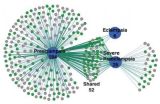(Press-News.org) Research by the University of Liverpool has found that brief musical training can increase the blood flow in the left hemisphere of our brain. This suggests that the areas responsible for music and language share common brain pathways.
Researchers from the University's Institute of Psychology, Health and Society carried out two separate studies which looked at brain activity patterns in musicians and non-musicians.
The first study looking for patterns of brain activity of 14 musicians and 9 non-musicians whilst they participated in music and word generation tasks. The results showed that patterns in the musician's brains were similar in both tasks but this was not the case for the non-musicians.
In the second study, brain activity patterns were measured in a different group of non-musical participants who took part in a word generation task and a music perception task.
The measurements were also taken again following half an hour's musical training. The measurements of brain activity taken before the musical training* showed no significant pattern of correlation. However, following the training significant similarities were found.
Amy Spray, who conducted the research as part of a School of Psychology Summer Internship Scheme, said: "The areas of our brain that process music and language are thought to be shared and previous research has suggested that musical training can lead to the increased use of the left hemisphere of the brain.
This study looked into the modulatory effects that musical training could have on the use of the different sides of the brain when performing music and language tasks."
Amy added: "It was fascinating to see that the similarities in blood flow signatures could be brought about after just half an hour of simple musical training."
Liverpool Psychologist, Dr Georg Mayer , explained: "This suggests that the correlated brain patterns were the result of using areas thought to be involved in language processing. Therefore we can assume that musical training results in a rapid change in the cognitive mechansims utilised for music perception and these shared mechanisms are usually employed for language."
INFORMATION:Notes to Editor:
*The musical training involved participants spending half an hour learning to tap three polyrhythms with their fingers. A polyrhythm is two more independent rhythms not devised from the same metre playing at the same time.
The research was presented at the British Psychological Society (BPS) Annual conference
Full paper title: 'The effects of musical training on cerebral lateralization patterns- a functional transcranial Doppler ultrasonography study.'
Musical training increases blood flow in the brain
2014-05-08
ELSE PRESS RELEASES FROM THIS DATE:
The Lancet: Antipsychotic medication associated with reduced rate of violent crime
2014-05-08
People who use antipsychotic medication (such as clozapine or risperidone) to treat psychiatric illness are nearly half as likely to commit a violent crime compared to when they are not using such medication, according to new results published in The Lancet. The use of mood stabilising drugs (such as lithium or carbamazepine) is also associated with a reduced rate of violent crime, although the reduction is less pronounced, and only in patients with bipolar disorder.
Antipsychotic and mood stabilising medication are used to treat a variety of disorders, but are most commonly ...
Study suggests improved survivorship in the aftermath of the medieval Black Death
2014-05-08
Human mortality and survival may have improved in the generations following the Black Death, according to results published May 7, 2014, in the open access journal PLOS ONE by Sharon DeWitte from University of South Carolina.
As one of the most devastating epidemics in human history, the medieval Black Death (c. 1347-1351) killed tens of millions of Europeans. Previous studies have shown that the disease targeted elderly adults and sick or stressed people; however, not much is known about any substantial changes in the population, like overall health and mortality, before ...
Scientists focus on role of ventilation in preventing tuberculosis transmission
2014-05-08
Scientists studying the role of room ventilation in tuberculosis transmission found that students in Cape Town, South Africa, spend almost 60 percent of their day in poorly ventilated rooms, at risk of transmission, according to results published May 7, 2014, in the open access journal PLOS ONE by Eugene Richardson from Stanford University School of Medicine and colleagues. The researchers propose an increase in low-cost, WHO-compliant natural ventilation to facilitate healthy indoor environments and reduce risks.
Despite biomedical improvements to treat tuberculosis ...
A new tool to measure the speed of aging
2014-05-08
A physical test for measuring age shows wide differences between the rates of aging among different population groups, according to new research by demographers at the International Institute for Applied Systems Analysis.
A strong handshake can say a lot about a person—it can indicate power, confidence, health, or aggression. Now scientists say that the strength of a person's grasp may also be one of the most useful ways to measure people's true age.
In a new study published today in the journal PLOS ONE, IIASA researchers Serguei Scherbov and Warren Sanderson (also at ...
UH Rainbow study finds rising incidence of acute pancreatitis in hospitalized children
2014-05-08
The largest investigation to date has found a significant increase in the number of acute pancreatitis (AP) cases in hospitalized children in the United States.
The new study, in the "PLOS ONE" journal found a 51 percent increase in the primary diagnosis of AP from 2000 to 2009. The number increased from 6,350 in 2000 to 9,561 in 2009.
The study looked at hospitalization records of patients 20 years old and younger using a federal children's inpatient database. From 2000 to 2009, they identified 55,012 cases of AP in hospitalized children ages 1 – 20.
According ...
Study finds genetic patterns in preeclampsia
2014-05-08
PROVIDENCE, R.I. [Brown University] — Different manifestations of preeclampsia, such as early vs. late timing or typical vs. high severity, appear to have distinct genetic underpinnings, suggesting that they may need to be studied and treated differently. That and several other insights are described in a newly published comprehensive review of genetic studies of the condition, which produces life-threatening complications such as high-blood pressure in as many as 8 percent of pregnancies in the United States.
"There are probably very different phenotypes of preeclampsia ...
Experts say 'insourcing' innovation may be the best approach to transforming health care
2014-05-08
Philadelphia - A group of health care and policy experts from the Perelman School of Medicine at the University of Pennsylvania is urging health care institutions to look more to their own in-house personnel, including physicians and nurses, as a source of new ideas for improving how care is delivered. The practice – referred to as insourcing – relies on an organization's existing staff to drive needed transformations. The team also suggests a four-stage design process which, when adopted internally, may help organizations implement more efficient health care delivery solutions. ...
New order of marine creatures discovered among sea anemones
2014-05-08
A deep-water creature once thought to be one of the world's largest sea anemones, with tentacles reaching more than 6.5 feet long, actually belongs to a new order of animals. The finding is part of a new DNA-based study led by the American Museum of Natural History that presents the first tree of life for sea anemones, a group that includes more than 1,200 species. The report, which is published today in the journal PLOS ONE, reshapes scientists' understanding of the relationships among these poorly understood animals.
"The discovery of this new order of Cnidaria—a phylum ...
Recent Ebola outbreak highlights need for better global response
2014-05-08
WHAT:In an invited perspective article on the Ebola outbreak under way in West Africa, Heinz Feldmann, M.D., Ph.D., of the National Institutes of Health (NIH) emphasizes the need for scientists to make their data available to colleagues in real-time to improve the public health response to outbreaks. He cites past responses to influenza and SARS (severe acute respiratory syndrome) outbreaks as successful examples of global information sharing. Rapid diagnoses are key to controlling outbreaks of deadly viruses such as Ebola, for which no therapies are available. The immediate ...
Malaria severity not determined solely by parasite levels in blood
2014-05-08
WHAT:
Although malaria kills some 600,000 African children each year, most cases of the mosquito-borne parasitic disease in children are mild. Repeated infection does generate some immunity, and episodes of severe malaria are unusual once a child reaches age 5. However, the relative contributions of such factors as the level of malaria-causing parasites in a person's blood—parasite density—to disease severity and to development of protective immunity are not well understood.
To clarify these issues, researchers from the United States and Tanzania regularly examined 882 ...



